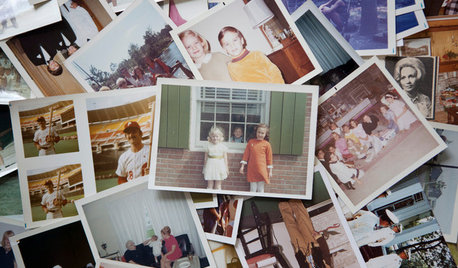Interesting article about effect of social media
3katz4me
3 years ago
Featured Answer
Sort by:Oldest
Comments (11)
Zalco/bring back Sophie!
3 years agoRelated Discussions
Interesting article for both sides
Comments (29)beginner's eye, "...your assuming the person apologizes and accepts your apology. what if they don't. is that the fault of the parent as well..." I'm going to take....fault of the parent out of this equation and provide another example here. Perhaps a non-apology was given. I have an older sister, who I'm estranged from. She was given to periodic calls out of the blue. Usually, she would rage at me, criticize, judge, etc. Sadly, she just could never connect to my feelings. The point is that it was all about her and her feelings. I got used to her negative judgments and criticisms. She was very aggressive, although I'm convinced that she never saw herself as an aggressive person. She always framed me as the problem. Once, at the urging of some therapy group she decided to make another call. By this time I equated all phone calls and every interaction with her as emotionally painful. As charastic of her, she demanded to know why I avoided her. My sister could never, never see how hurtful her behavior was. EVER! Then she said to me, "...If I apologize, will it make things better?" This took me by surprise and there was a long history of her emotional outbursts, anger and denial. I responded saying I guess so. Then she got mad. Then immediately after she made another very telling comment, she said,"I DON'T GET ANY OF THIS." I was in therapy at the time and discussed her non-apology with my therapist and why I felt it was insincere--it was a very telling comment to me. She was apologizing for behavior that she didn't UNDERSTAND, because as she said, "She didn't get any of this." Neither could the rest of my family and the rage, anger and blame continued from them. My response was to distance myself even further. The concept here is that if someone truly doesn't understand how hurtful and destructive their behavior is (and will not own it and don't understand it), then I'm certain that the behavior will continue and there will be repetition. This may not be the best example, but think of a wife-beater who abuses his wife, then profusely apologizes with flowers, gifts and she reconciles. Then he beats her again, even more cruely than the first time. Then her well-meaning friends or relatives say, "she allowed herself to be manipulated, abused," or they may encourage her to "forgive and forget". Plenty of people MINIMIZE emotional abuse and the damage it creates, because unlike physical abuse you can't see it, therefore if you can't see it, it must not exist. I can assure you my estrangement from my sister is NOT TO PUNISH her. It is 100% about PROTECTING MYSELF and PROTECTING my emotions. It is not because I do not want "...resolution/reconciliation/closure/healing". Of course, I want that. I also want change and I want her destructive behaviors to STOP. I want her to demonstrate AWARENESS and I want to be convinced that she UNDERSTANDS why she is apologizing. I'm not interested in prolonging the conflict. I'M NOT INTERESTED IN PROLONGING EMOTIONAL ABUSE with someone who DOESN'T UNDERSTAND my feelings. I am also not looking for perfection of character. Responsibility and awareness, YES. That is what I am looking for. My intest is in preserving some sense of myself and protecting myself. I posted on another thread about the Art of Apologizing....See MoreTesting social media share bar
Comments (150)I am amazed at how many other GWers are also not involved in social networking. My adult daughter and I are both professionals in separate professions and chose to avoid social networking for a multitude of reasons, including the importance to us of keeping clients etc. removed from our personal lives, along with little faith that what may be posted privately now will always remain that way. Clearly the rug of rules that may seem comfortably woven in place can at any time be yanked from under. I believe GW appeals to a diverse but like minded set that seek out/stumble into GW and stay due to the different type of social and informational connection IT provides - like falling down the well and discovering a new land, or joining a secret club or society - some above refer to GW as a treasure; a treasure is something valuable and special - something you may not want to share even....I imagine part of the distress that the idea of FB linkage creates for some people, including myself, is that whether fears are real or perceived, pointing highway signs and creating easy access usually does ruin what is special....think new turnpike exits to quaint towns, or bigger roads and hotels in formerly remote and pristine parks. Precisely why GW *IS* treasured by so many is reason enough that it should not be recklessly or greedily manipulated as it will likely cease to maintain it's attraction and specialness. Thank you Tamara for this reprieve - hopefully it will not be temporary. This post was edited by peegee on Sat, Dec 8, 12 at 15:44...See MoreTeen social media use
Comments (39)I work with adolescents so I am forced to keep up with this stuff :-) My DS is 10, and I dread the day he gets involved with it all. Some things I have learned, FYI-- Icky, but good to know-- There are now several apps available that "capture" Snapchats. So the sender believes the message will disappear, but the recipient can save it and distribute it. This is frequently used for the sexy/naked images or supposedly private comments dumb kids send each other. There are apps specifically designed to deceive parents looking through their kids' phones. The icon on the phone will look like something innocent, like a calendar or whatever, but when you click on it, it takes you to a password protected messaging or "dating" service. Many of these apps are used by sexual predators; kids get suckered in by the "privacy" aspect. Sending/receiving nude pics of someone under 18 (even when a kid is sending images they have taken of themself) can result in charges of distributing child pornography. Seriously....See MoreBreaking up with social media
Comments (60)Well if you look at what the fake accounts on FB were doing in the election, they were just posting negative rumor type things on both sides. They were "fake" in that the people were pretending to be groups that they were not, but do we really care or parse where our memes come from? I try but a lot of it is ubiquitous. The fact that folks got caught up in posting it says more about human nature than FB being responsible. Smear campaigns are as old as the hills. But the issue is, if you have your phone with you and are on social media 24/7, then just the atmosphere it creates in your life will influence you. The memes mostly stoked divisions, fear and hate in the populace, for both parties actually. This is an age old technique. Just repeat things in the background and folk will pick up on it as truth, whether they are paying much attention or not. Repeat a lie something like 19 times and folks will think it is the truth. So if you see it 19 times on a pamphlet, hear it in the halls of your high school, or have it pop up on your phone, it's pretty much the same as far as being bad. The difference is how intense and long lasting it is when it is on a device that you are attached to all day long. That's why I am torn. I want the pluses of having my device for positive communication, but want to weed out the negative. This is something my husband and I disagree on, I try to stamp out saying toxic things and having toxic thoughts and hearing toxic sounds that I don't want to influence my life in toxic ways. Hubs says, "oh come on, it's just a movie, or it's just a joke or it's just a tv show, etc." He denies being negatively influenced by watching and hearing angry people argue all day on TV. Hubs and I are basically on the same page with big political issues but not on the same page about how to speak and act and what kinds of atmosphere to immerse oneself in. I think that's because hubs grew up in a toxic home and then had a toxic first marriage. He learned to wall himself off from his surroundings. It's difficult to teach an old dog new tricks. Particularly if the dog doesn't want to learn. So a lot of the time I have to say, "Go ahead and listen or get involved in that, but leave me out of it." He does a lot of positive things too, so far the scale is far down on the positive end, although sometimes it wobbles. My best friend has a similar issue in her long marriage, she says, "Politically and socially we totally agree. But how to load the dishwasher, how often to clean the car, what time to leave for an event, and a thousand other daily tasks we disagree vehemently on." They have contrasting personal styles as do my husband and I, introvert/extrovert, etc. But then he's a contrarian and if I say he's one way, no matter what it is, he will deny it. He often argues he likes something one day and doesn't like it the next, I can't keep track sometimes! Deny or not, the marketers know a lot about how it works, the FB data miners were sophisticated enough to mine and parse information from FB accounts to figure out who was vulnerable to what messages. No different than FB figuring out which ads to show you or tv advertisers knowing who is watching what shows so they can sell air time to companies to advertise. The only difference is that FB did not pay very much attention to what folks were doing with what they sold them. Candidates want to speak with constituent groups and get their message out to them. But what about folks who want to poison the well? Negative campaigns work, spreading insinuating and biased disinformation works. That's the real kicker for me, how do I watch tv, use my phone and even pump gas for heaven's sake and not be bombarded by this stuff? How do I keep the good and weed out the bad? Every time I turn around, some type of haranguing media is on somewhere . . . The tv station doesn't refuse to air a political add because it is biased does it? And yet most people loathe having to listen to that stuff . . . and yet is persists because it works . . . agh!...See More3katz4me
3 years agojrb451
3 years agoarcy_gw
3 years agoSpringroz
3 years agoIdaClaire
3 years ago3katz4me
3 years agoLars
3 years agocawaps
3 years agoBestyears
3 years agoreneburlin
2 years agolast modified: 2 years ago
Related Stories

LATEST NEWS FOR PROFESSIONALSHow to Find Your Social Media Voice
Pros share key tips for communicating your brand’s identity online
Full Story
ARCHITECTUREDesign Workshop: The Intriguing Effects of Exposed Framing
Reveal the structure of your home for interesting design opportunities and eye-catching visual effects
Full Story
WORKING WITH PROSWhat to Know About Working With an Interior Designer
Find out how to have a more productive and cost-effective relationship with your design pro
Full Story
WALL TREATMENTS9 Creative Paint Effects Remake These Rooms
See how designers mix and match colors to highlight or disguise architectural features and lend interest to walls
Full Story
HOME TECHWhat Chipotle and Radiohead Can Teach Us About Sound Quality at Home
Contemporary designs filled with glass and concrete can be hostile environments for great sound quality. Here's how to fix that
Full Story
TASTEMAKERSA Designer Edits — and Adds — for Dramatic Effect
Interior designer Nancy Braithwaite’s new book shows how it’s possible to edit rooms of all styles to create their best look
Full Story
MOST POPULARWhat to Know About Adding a Deck
Want to increase your living space outside? Learn the requirements, costs and other considerations for building a deck
Full Story
COLORBye-Bye, Minimalist White — The New Nordic Style Is All About Color
The Scandinavian color palette is moving away from pale, cool shades with hot new hues on walls and floors
Full Story
COLOR8 Neutral Rooms That Sneak In Color Interest
Kick up your favorite palette's visuals without diluting the tone-on-tone look, following the lead of these sophisticated spaces
Full Story
ORGANIZINGWhat to Know About Digitizing Your Photos
You can do it yourself with a scanner or smartphone app, or hire a mail-in service or local pro to do it for you
Full Story



maddielee